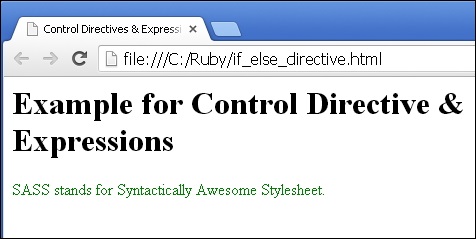
- Sass Tutorial
- Sass - Home
- Sass - Overview
- Sass - Installation
- Sass - Syntax
- Using Sass
- Sass - CSS Extensions
- Sass - Comments
- Sass - Script
- Sass - @-Rules and Directives
- Control Directives & Expressions
- Sass - Mixin Directives
- Sass - Function Directives
- Sass - Output Style
- Extending Sass
- Sass Useful Resources
- Sass - Interview Questions
- Sass - Quick Guide
- Sass - Useful Resources
- Sass - Discussion
Sass - @else if Directive
Description
The @else if statements are used with the @if directive. Whenever the @if statement fails then the @else if statements are tried and if they also fail, then the @else is executed.
Syntax
@if expression {
// CSS codes
} @else if condition {
// CSS codes
} @else {
// CSS codes
}
Example
The following example demonstrates the the use of @else if directive −
<html>
<head>
<title>Control Directives & Expressions</title>
<link rel = "stylesheet" type = "text/css" href = "style.css"/>
</head>
<body>
<div class = "container">
<h1>Example for Control Directive & Expressions</h1>
<p>SASS stands for Syntactically Awesome Stylesheet.</p>
</div>
</body>
</html>
Next, create file style.scss.
style.scss
$type: audi;
p {
@if $type == benz {
color: red;
} @else if $type == mahindra {
color: blue;
} @else if $type == audi {
color: green;
} @else {
color: black;
}
}
You can tell SASS to watch the file and update the CSS whenever SASS file changes, by using the following command −
sass --watch C:\ruby\lib\sass\style.scss:style.css
Next, execute the above command; it will create the style.css file automatically with the following code −
style.css
p {
color: green;
}
Output
Let us carry out the following steps to see how the above given code works −
Save the above given html code in if_else_directive.html file.
Open this HTML file in a browser, an output is displayed as shown below.

sass_control_directives_expressions.htm
Advertisements